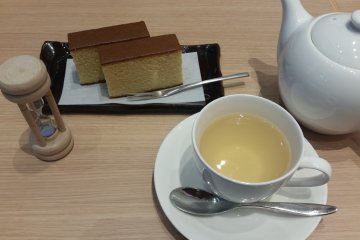One lifetime is not enough to try the sweets in Japan from traditional wagashi to pastries and chocolates from famed French confectioners to hybrid creations melding East and West.
Japanese language sparkles with onomatopoeia (words that sound like their meaning). Charin charin (the sound of a bicycle bell). Potsu potsu (light rain). Kuru kuru (sushi conveyor belts). Come along a sensory tour of Japan’s most delectable desserts!
Mogu mogu (to chew a lot) - Mochi
The first sweets were dried fruits and nuts. Buns and dumplings arrived from China in the 8th century. The Japanese started making rubbery mochi from steamed and pummelled rice. Today it’s dipped in soy sauce or filled with beans, fruit, cream or ice cream.

Children are shown a rabbit pounding mochi with a mallet on the moon. Celebrities thwack it on TV. It’s thrown at neighbours when building a new house. Sadly, every New Year around ten elderly people die choking on the customary blobs.
Warabi mochi (from bracken root starch) are softer, jiggly cubes topped with kuromitsu brown sugar syrup and kinako roasted soybean powder.
Tsubu tsubu (chunky, small bits) - Matcha Parfait
From the 16th century, wagashi evolved with tea ceremony culture. They’re exquisite miniature artworks but Westerners might find them an acquired taste. Like yokan – brown seaweed jelly blocks with red bean, sweet potato or chestnut.
More modern matcha green tea sweets draw crowds at cafes like Saryo Tsujiri, from Kyoto. The parfaits are subtly sweet, textural delights with mochi balls, berries and matcha ice cream, whipped cream and sponge.
Japanese food is generally less sweet than in the West. Europeans imported cane sugar in the 16th century. It was an expensive rarity until the Japanese cultivated it in the 17th century and not widely used until after the mid-19thcentury.
Fuwa fuwa (soft, fluffy) - Western Style Cakes
Westerners introduced baking with flour, butter and sugar. The Portuguese brought kasutera castella in the 16th century via Nagasaki. Try this moist sponge at Bunmeido, a chain from Nagasaki.

Japan has little domestic baking tradition. Many people don’t own ovens and go out for cake and pastries. Strawberry shortcake - sponge, cream, fresh strawberries - has become Christmas custom (shared after Kentucky Fried Chicken).
Zaku zaku (crunching) - Dove Sable Biscuit
Kamakura’s famous souvenir, the Hato Sabure, is also sold in nearby Tokyo and Yokohama. Created in 1912, each butter biscuit is handmade perfection.
From 1853, America forced Japan out of around 200 years of near isolation and Western influences streamed in. Baked goods gained favor. Post World War II ravaged Japan, unable to grow enough rice, received bread and flour from the US. In 2011, spending on bread surpassed rice.
Sube sube (smooth, rounded) – Dairy Desserts
Dairy was another Western concept and initially deemed repulsive. Today, fans gush over pancakes toppling with cream. Queues swell for cheesecakes at Osaka brands Pablo (choose from rare and gooey or medium and firm) and Rikuro Ojisan.
Toraya, founded in early 1500s Kyoto, provides sweets to the Imperial Palace. Old-style wagashi sales have fallen. Toraya’s Omotesando Hills Tokyo café serves updated desserts like pudding with kuzu (root starch), caramel sauce and a citrus jam centre.

Yokohama claims Japan’s first ice cream shop from 1865. Soft serve in Japan, called “softcream”, comes in flavours wacky even to the Japanese. Squid, spinach, sea urchin, corn soup, wasabi, whitebait, seaweed…
Don’t miss Cremia - crammed with Hokkaido whipped cream and milk fat. Vanilla is the only choice but it’s sinfully lush.
Toro toro (melts in the mouth) – Chocolate
It’s believed Dutch sailors introduced chocolate hundreds of years ago but it really caught on after World War II during the US occupation. American soldiers tossed it to smitten children. High-end chocolate stores boomed from the early 2000s.
KitKats arrived in 1973 as a marketing dream, sounding like “Kitto katsuto” (“win for sure”). They became good luck charms, especially for pre-exam students. Hundreds of zany flavours have included pineapple, soy sauce, sake, sports drink, aloe yoghurt, ginger ale and apple vinegar.
KitKat Premium Chocolatories sell more expensive concoctions like Hokkaido butter or Uji matcha with sakura (cherry blossom).
Hokkaido cream is the star again in Royce nama fresh chocolate. The Calbee snack brand’s Royce-smothered potato chips are a sweet/salty mash up.
Older Japanese may feel nostalgic pangs for the roasted sweet potato vans that still ring with vendors’ cries, “Yaki-imo, yaki-imo!” but most sweet tooths today crave more than a cooked tuber.
Japan is a food-obsessed nation. You’ll be in a constant state of doki doki (heart pounding) and waku waku (excited anticipation) discovering its endless treats. It really is the best place to gaba gaba (continually eat with gusto)!
Sources: Richie, D., A Taste of Japan, Kodansha International Ltd, 1990
Sosnoski, D., An Introduction to Japanese Culture, Tuttle Publishing, 1996
Sakamoto, Y., Food, Sake, Tokyo, The Little Bookroom, 2010
Confectionary, Begin Japanology, (documentary), NHK (Japan Broadcasting Corporation), 2012
Mochi Rice Cake, Begin Japanology, (documentary), NHK (Japan Broadcasting Corporation), 2013
Wagashi, Japanology Plus, (documentary), NHK (Japan Broadcasting Corporation), 2014









